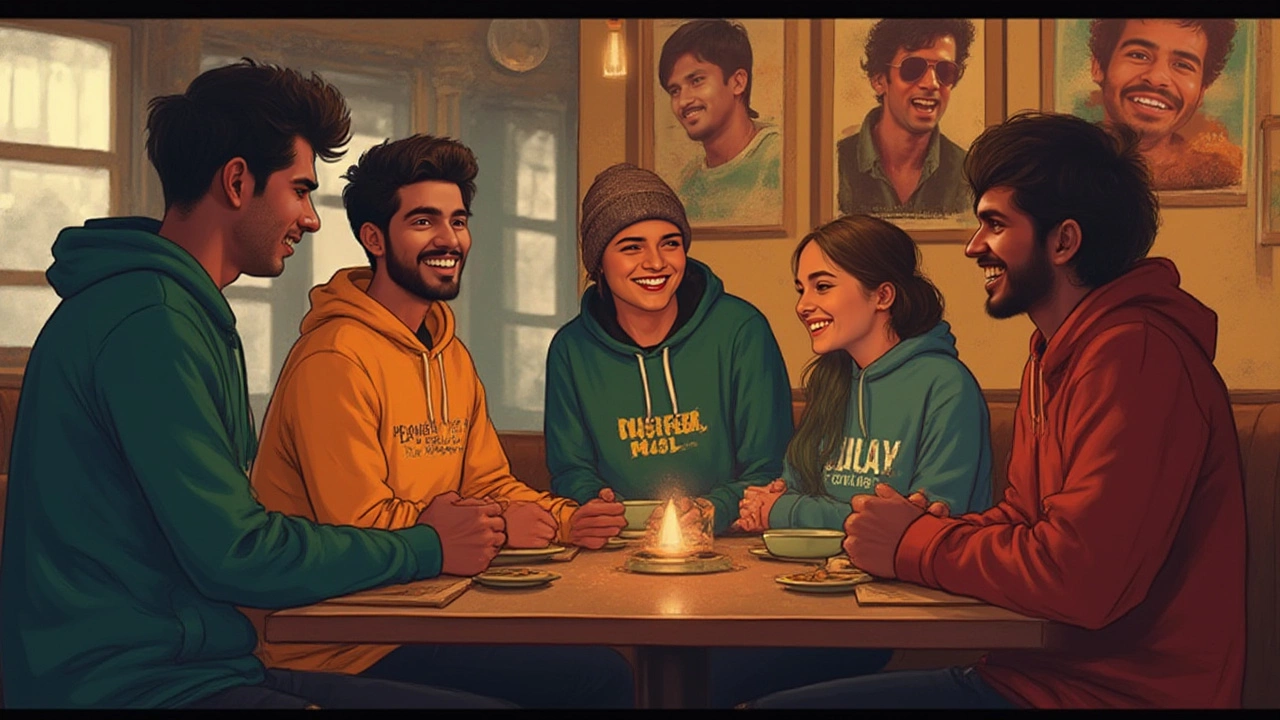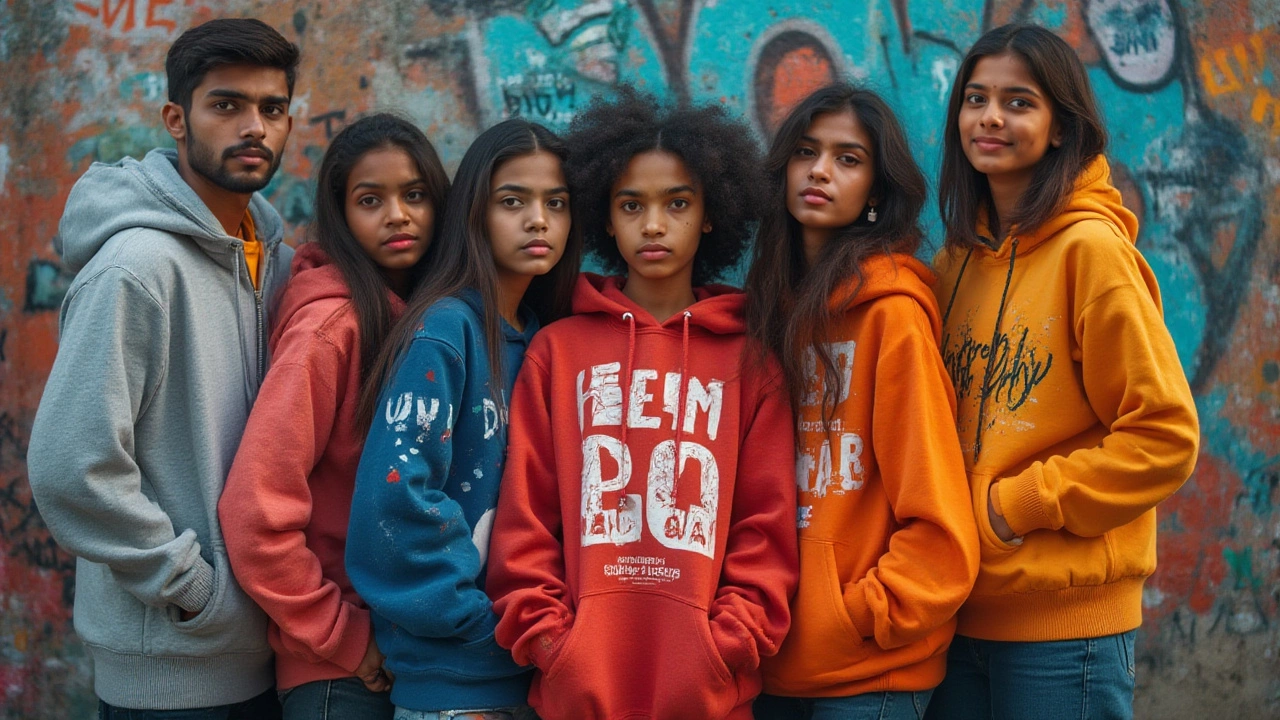You ever stop to think just how loaded a word like “hoodie” is? To some, it’s just that soft, comfy sweatshirt hanging on the back of a chair. To others, it’s a fashion power move, a whole attitude, or even a generational signal. In some circles, the word “hoodie” goes way beyond something you pull on to fend off a cold breeze. Let’s untangle the roots and layers behind hoodie slang, and see how this simple piece of clothing gained a language—and meaning—all its own.
The Origins and Evolution of 'Hoodie' in Slang
So where did “hoodie” even come from, anyway? The term started as practical as can be: it’s short for ‘hooded sweatshirt.’ But by the late 90s and early 2000s, the slang took on a whole different life. The very first hooded sweatshirts popped up in the 1930s, thanks to Champion, a company making tough gear for workers braving cold storage units. Still, nobody called them hoodies yet. That nickname took a while to catch on. By the 1970s, “hoodie” finally made its debut in American English, and it's since become the dominant term.
Language is a living thing, though, and the meaning of “hoodie” didn’t just stick with gear. By the time hip-hop culture hit its stride in the 80s, skateboarding exploded, and ‘streetwear’ started making headlines, hoodie slang shifted. It morphed into code for more than just a sweatshirt; it started summoning images linked with urban youth culture and rebellion. “Wearing your hoodie up” wasn’t just for warmth—it meant defiance, privacy, or sometimes even just wanting to tune out the world for a bit.
By the early 2000s, “hoodie” was everywhere. Jay-Z wore one at concerts, Mark Zuckerberg famously rocked one at business meetings, and the British press debated the so-called “hoodie ban” to fight youth crime. The word itself became shorthand: people started saying “Hey, nice hoodie,” meaning your style was on point—maybe even a little daring. The 2010s took the hoodie from street to chic: runways, red carpets, and luxury designers all started embracing hoodie culture, and the term “hoodie” left its gritty roots behind, at least for a while.
Throughout all that, slang kept shifting around the hoodie. Teenagers joke about “hoodie season” (when it gets cold and everyone’s living in sweats). A “boyfriend hoodie” became cult code for borrowing your partner’s oversized favorite. And sometimes, “hoodie” itself stands for a whole persona—like saying someone is a “hoodie guy” or “hoodie girl,” meaning ultra-chill, mysterious, maybe a little bit introverted.
Hoodie Slang Through Different Lenses
The fun thing about hoodie slang is that context is everything. In the US, “hoodie” is pretty universal—it’s as straightforward as “jeans.” But check out the UK, and you’ll find the word comes loaded with stereotypes. “Hoodies” there once got unfairly lumped in with ‘chav’ culture, a loaded UK slang for working-class youth seen as rebellious or tough. British politicians tried to ban hoodies from shopping centers in the mid-2000s, and the tabloids ran wild with the idea. That led to a counter-movement: young Brits started calling themselves “hoodies” as a badge of pride, shifting the slang into something powerful, even a little political.
In pop culture, hoodies have played starring roles everywhere from music videos to movie scenes. Think Rocky Balboa training in that gray hoodie, Eminem in 8 Mile, or every moody superhero in civilian clothing. The hoodie became more than cloth and cotton—it started symbolizing resilience, self-expression, or sometimes, a shield against the outside world. “Putting the hood up” is daily life code for “don’t talk to me” in libraries, skate parks, and schools everywhere.
And hoodie slang doesn’t stop there. Fashion brands love to coin their own hoodie terms—oversized, cropped, zip-up, pullover. Skateboarders drop “hoodie drop” for exclusive releases. On TikTok, “hoodie vibe” trends signal that special mix of confidence and chill that comes from rocking your favorite sweatshirt. Gamers swap out words like “skin” or “fit” for hoodie digital gear, and artists give songs names like “Hoodie Weather” to capture moody, cozy energy.
Social media has made hoodie slang even more rapid-fire. There’s “Hoodie Stealth” for sneaking snacks in class, “Hoodie Friend” for that chill buddy who never gets too worked up, “Hoodie Hug” for finding comfort in oversized sleeves. The slang shifts from group to group but always keeps that underlying idea—a hoodie is never just what it seems.

Facts, Stats, and Surprising Truths About Hoodie Culture
Hoodies are everywhere—no exaggeration. In 2020, global hoodie sales topped $28 billion, according to Statista, and the number keeps rising. A new hoodie drops on shop websites every single day. If you walk through a college campus, you’ll see more hoodies than blazers by a mile, and owning at least three hoodies is basically a requirement for Generation Z. Plenty of adults keep one hidden in their car or office, claiming it’s “just in case”—when really, it’s for that instant comfort hit.
Check this out:
| Year | Estimated Global Hoodie Sales ($Billion) | Hoodie Popularity Index (1-10) |
|---|---|---|
| 2010 | 8.1 | 5 |
| 2015 | 14.4 | 7 |
| 2020 | 28 | 9 |
| 2024 | 34 (est.) | 10 |
But the hoodie isn’t just for comfort—studies have found it connects to psychology, too. There’s even research showing that wearing a hoodie increases the feeling of protection and reduces social anxiety for some people. That might explain why you’ll see such a big crossover between “hoodie culture” and creative fields like art or gaming, where people spend long hours focused solo and need a kind of wearable shield.
Here’s a neat fact: “hoodie up” was added to Urban Dictionary in 2008, meaning “to put your hood on,” and it’s still used today. And according to Google Trends, searches for “how to style a hoodie” spike every autumn—proof that hoodie slang isn’t slowing down. Now, look at how a single tragic event can flip hoodie symbolism. After the Trayvon Martin case shook the US in 2012, the hoodie became a national symbol for social justice, with activists wearing hoodies at rallies to reclaim the term and shape public conversation.
Famous designer Virgil Abloh once said, “The hoodie is the closest thing to being Superman that you can wear.” He’s right. Every time someone pulls up their hood—whether they’re nervous, tired, or just want to disappear for a bit—they’re making a statement, even if it’s just for themselves.
It’s not all deep symbolism, though. There are hundreds of hoodie memes, from “when you steal your crush’s hoodie” to the obsession with “hoodie paws” (when your sleeves are long enough to hide your hands). And if you’ve ever stayed up late scrolling, you’ve most likely heard the phrase “It’s hoodie o’clock”—it just hits different after midnight.
Tips for Mastering Hoodie Slang and Hoodie Culture
If you want to stay ahead in hoodie language—and let's be real, who doesn't?—it’s worth knowing the basics and then some. For starters, don’t just call every sweatshirt a hoodie. Real hoodie fans cringe when someone confuses a crewneck (no hood) with the real thing. Picture this as slang code: “crewneck” is hoodless, “hoodie” has the all-important hood (and usually those handy front pockets).
Sizing matters, too. “Oversized hoodie” is code for ultimate comfort or hiding a night of bad sleep. “Slim-fit hoodie” shouts a more athletic, put-together vibe. In group chats, “hoodie swap” often means giving your favorite to a best friend or love interest—a time-honored gesture in teen romance flicks.
For those who want to flex some hoodie lingo, here are a few real-life uses:
- Hoodie slang at its core means calling something or someone out by their hoodie ("he's a hoodie guy").
- "Hoodie up": Pulling that hood over your head, looking mysterious or anti-social, or just tuning out.
- “Hoodie weather”: That perfect chill in the air—autumn and early spring—when you’d rather live in your hoodie than anything else.
- “Borrowing a hoodie”: In dating, it’s way more serious than it sounds; giving your hoodie away is a kind of relationship milestone.
- “Hoodie paws”: Those baggy sleeves long enough to hide your hands; seen as cute or comforting.
- “Hoodie drop”: A limited release of special or designer hoodies, often hyped up on social media.
- “Hoodie squad”: A friend group that always, and I do mean always, wears hoodies no matter the event.
Want to make hoodie slang second nature? Pick out different styles for different moods: a zip-up for casual days, a pullover for lazy ones, a bold graphic hoodie when you want to turn heads. Pay attention to details—kangaroo pocket, ribbed cuffs, cotton weight. The way you style it, layer it, or even roll the sleeves automatically says something about who you are.
One tip from the pros: take care of your hoodie if you want it to hold up. Wash it inside-out, avoid high heat, and keep your best hoodies out of the dryer. A treasured hoodie can last for years and sometimes carries more memories than your yearbook. Next time someone comments on your hoodie, remember—they’re not just talking about a sweatshirt. They’re clocking on to your story, your style, your whole vibe.
"The hoodie has gone from utilitarian essential to icon of style, comfort, and resistance all at once." – GQ Magazine, 2023
If there’s one thing true about hoodie slang, it’s that it’s always changing—but the love for the hoodie itself never fades. So, embrace the lingo and let your hoodie say what you can’t.
